About OneDrive
Developed by Microsoft, OneDrive is a file hosting service and file synchronization service that syncs files between your computer and the cloud. It allows you to share files and sync files across Android, iOS mobile devices, Windows, or macOS computers.
A file or folder that is added, modified, or removed from your OneDrive folder is also added, modified, or removed from the OneDrive website, and vice versa.
Even when you’re not online, you may access and interact with your synchronized files immediately in File Explorer. Any modifications you or others make will automatically sync while you’re online.
OneDrive boasts a series of helpful features. For instance,
- Back up and sync files and folders to the cloud.
- Offload local files to the cloud to free up local storage space.
- Seamless Microsoft 365 and Windows integration.
- Present and manage photos online.
- Access your data instantly, anywhere, and at any time.
- Personal Vault adds an extra degree of security for your data.
- View, look up, and work with OneDrive files from File Explorer without having to download them all to your device.
As everyone knows, OneDrive has been built into the Windows 11/10 system, so you don’t need to download and install it.
In this case, can you turn off or remove OneDrive from your computer? How to disable OneDrive? What are the consequences if it is disabled or uninstalled? Will uninstalling it cause data loss? Are there any other software available for syncing files?
In this post, we will answer these questions for you. Let’s get started.
Quick video guide:
Can You Turn Off OneDrive in Windows 11/10?
Is disabling OneDrive a good idea? Many Windows users are curious about this. The answer is yes. If necessary, you can disable OneDrive.
As mentioned above, OneDrive is a feature-rich synchronization software. However, in some cases, disabling OneDrive might be more preferable.
If you disable OneDrive, your files will no longer be synchronized between your computer and the cloud. However, the files on your computer will remain in the original location. And your cloud-based files can be accessed on the OneDrive website.
Overall, closing OneDrive will disable automatic syncing. Nevertheless, you can also access, manually upload, or download your existing online/local files in the OneDrive webpage. You can still manually open OneDrive and reactivate the synchronization at any time.
If you are experiencing any of the following situations, then you can turn it off.
1. Limited Bandwidth or Unstable Network Connection: The continuous sync of OneDrive will quickly consume data traffic and affect other network activities. Under intermittent network conditions, OneDrive may not be able to steadily synchronize files.
2. Insufficient Disk Space or OneDrive’s Free Space: If your free 5GB space is full and you don’t want to pay for an upgrade, sync may stop with continuous boring prompts. Turning off OneDrive can avoid this at this time.
3. Pursuit of Device Performance: OneDrive may cause performance issues on older or slower systems. The continuous file sync leads to an increase in system resource usage, slowing down your PC. If your PC isn’t performing well, you can disable OneDrive.
4. High Data Privacy and Security Requirements: If you are dealing with sensitive content such as business secrets, financial data, or personal information, disabling public cloud storage is a basic security measure.
5. Conflict with Certain Applications: In some cases, OneDrive may conflict with specific software, causing system lag or crashes. When troubleshooting issues, temporarily disabling OneDrive is an effective diagnostic step.
6. Errors of OneDrive Itself: If OneDrive itself has an irreparable error, sometimes completely uninstalling and reinstalling is the ultimate solution.
In the following section, we will demonstrate to you how to turn off, uninstall, and remove OneDrive.
How to Disable OneDrive on Windows 11/10
1. Unlink OneDrive from Your PC
Step 1. Locate and tap the cloud icon in the taskbar > hit the gear icon in the top right corner > choose Settings.
Step 2. In the OneDrive Settings window, go to the Account section > click Unlink this PC > hit Unlink account to confirm.
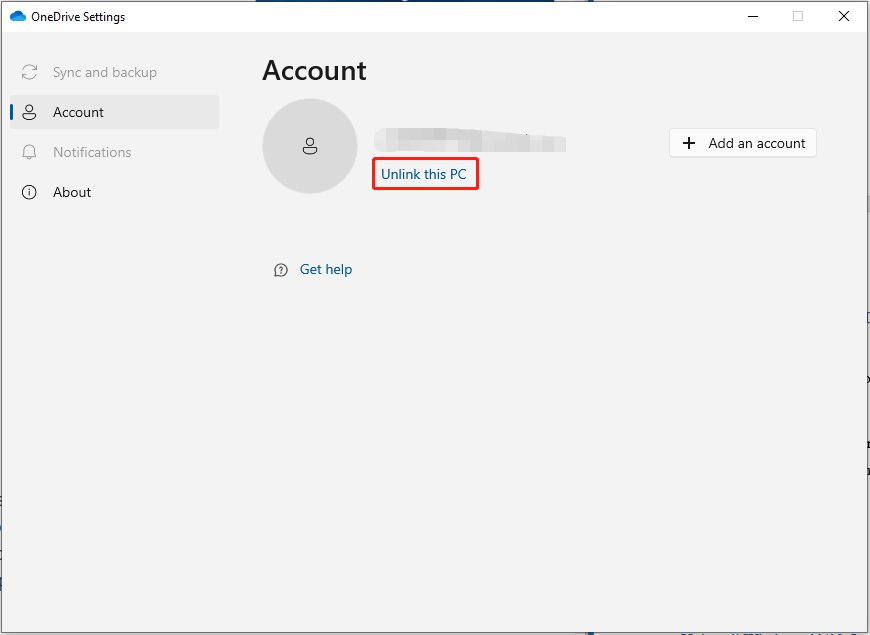
Open OneDrive again, and you will see that you’ve completely logged out of OneDrive from your computer. It means you have successfully stopped OneDrive in Windows 11/10.
Here is a quick video guide:
2. Turn off OneDrive via Group Policy
Step 1. Press Win + R to open the Run window > type gpedit.msc > hit OK.
Step 2. In the Local Group Policy Editor window, navigate to the OneDrive folder via the path: Computer Configuration > Administrative Templates > Windows Components > OneDrive.
Step 3. Double-click on Prevent the usage of OneDrive for file storage.
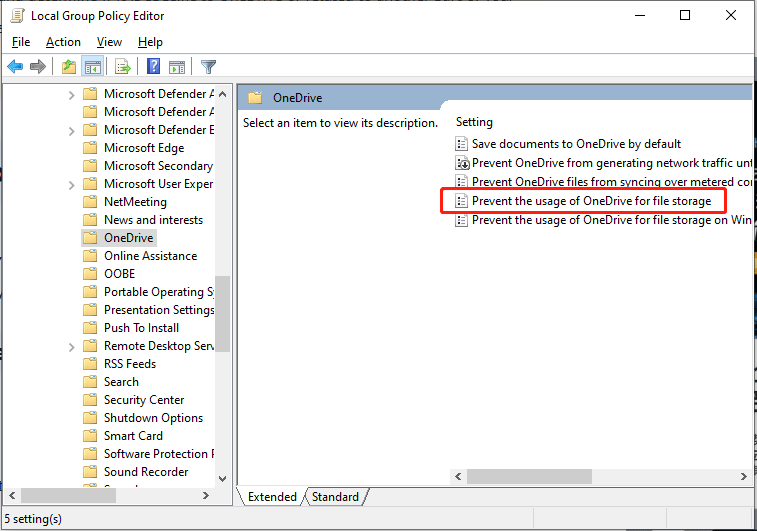
Step 4. In the newly popping-up window, choose Enabled > click Apply & OK to save the changes.
After that, restart your computer. You may still find that OneDrive is still in File Explorer, but it is not available now.
3. Disable OneDrive in Registry Editor
Step 1. Launch the Run box by pressing Win + R > input regedit > press Enter.
Step 2. In the Registry Editor window, navigate to the following path: HKEY_LOCAL_MACHINE\SOFTWARE\Policies\Microsoft\Windows
Step 3. Right-click on the Windows key > choose New and then Key from the context menu.
Step 4. Name the new key as OneDrive > select the OneDrive key > right-click on the blank space in the right.
Step 5. Choose New > DWORD (32-bit) Value > set the name as DisableFileSyncNGSC.
Step 6. Double-click the DisableFileSyncNGSC item > change the Value data to 1 > hit OK.
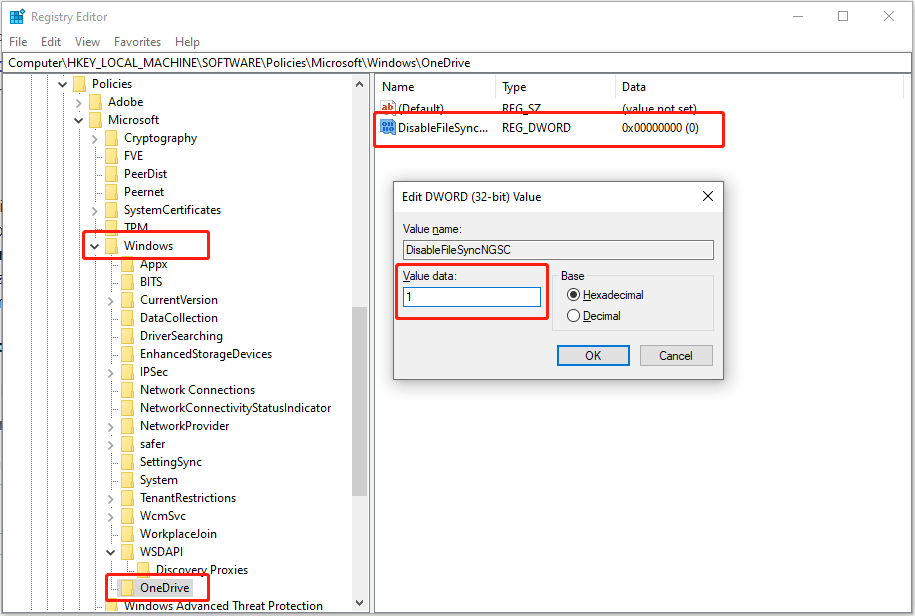
When you have finished all steps, close the Registry Editor window and reboot your PC to make the changes take effect.
How to Uninstall or Remove Windows 11/10 OneDrive
When you are fed up with the endless OneDrive pop-ups or the crashed OneDrive, you might want to permanently get rid of it. You can achieve it through Control Panel and Command Prompt. Let’s see how to uninstall OneDrive:
# Use Control Panel
Step 1. Type Control Panel in the search box and choose the best match.
Step 2. Set View by to Category > click on Uninstall a program under Programs.
Step 3. Find and right-click Microsoft OneDrive to choose Uninstall.
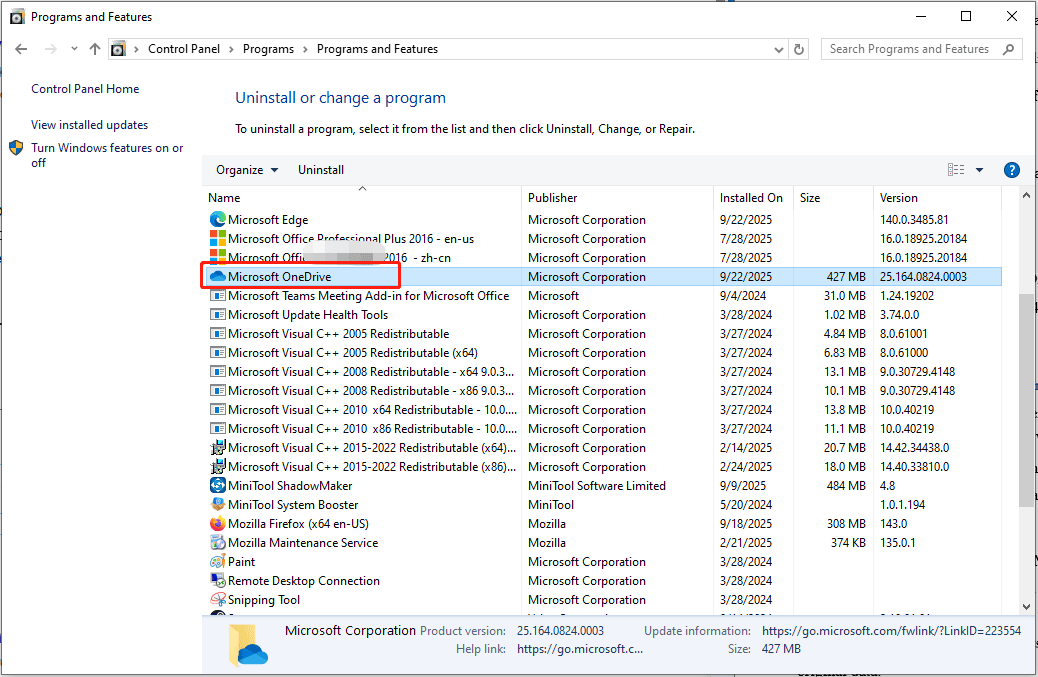
# Apply Command Prompt
Step 1. Run Command Prompt as an administrator.
Step 2. Execute the list of commands below in order:
- taskkill /f /im OneDrive.exe
- %SystemRoot%\System32\OneDriveSetup.exe /uninstall (for 32-bit Windows 10)
- %SystemRoot%\SysWOW64\OneDriveSetup.exe /uninstall (for 64-bit Windows 10)
MiniTool ShadowMaker – Best Alternative to OneDrive
Backing up data in today’s digital life is necessary. OneDrive is used for cloud syncing, but it relies heavily on a stable network. Once the internet connection is unstable, you will be unable to back up or sync files.
Thus, we’d like to introduce an alternative to OneDrive, which is MiniTool ShadowMaker. Available on Windows 11/10/8/8.1/7, this backup software allows you to back up your computer locally.
Different from OneDrive, MiniTool ShadowMaker can only sync and back up files locally, that is, transfer your files to a local device such as a hard disk drive, solid-state drive, USB flash drive, external hard drive, NAS, etc.
Besides, it’s a pity that this freeware only supports one-way sync because it puts more emphasis on maintaining the integrity of the original data.
But what can make up for this deficiency is that this tool contains some powerful features, such as file backup, partition backup, system backup, disk backup, and disk clone.
Here’s how to carry out a file sync with MiniTool ShadowMaker:
Step 1. Run This Software
1. Download and install the 30-day free trial of this software for Windows.
MiniTool ShadowMaker TrialClick to Download100%Clean & Safe
2. Launch it and hit Keep Trial to enter the main interface.
Step 2. Select the Sync Source and Destination
1. Navigate to the Sync page.
2. Select what to sync from SOURCE and where to store them in DESTINATION.
Sync source – click on SOURCE, and then you can pick the files and folders you want to sync.
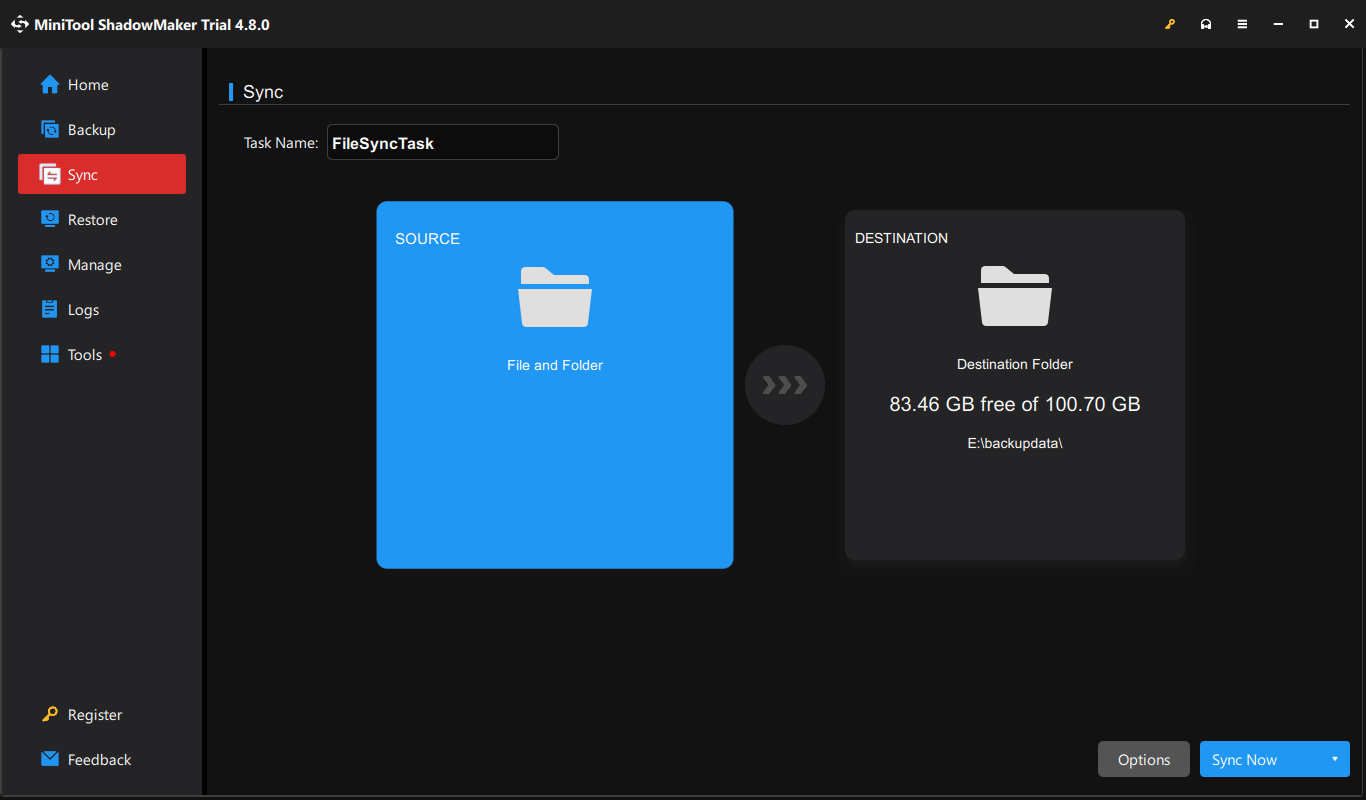
Sync destination – go to DESTINATION to select a storage path for the sync task. There are 4 types of sync destination options available for you:
- User – refers to all folders inside C:\Users\username.
- Computer – lists all the drives that Windows can detect.
- Libraries – represents all the folders in C:\Users\Public.
- Shared – syncs to a shared folder from another Windows PC in the same LAN.
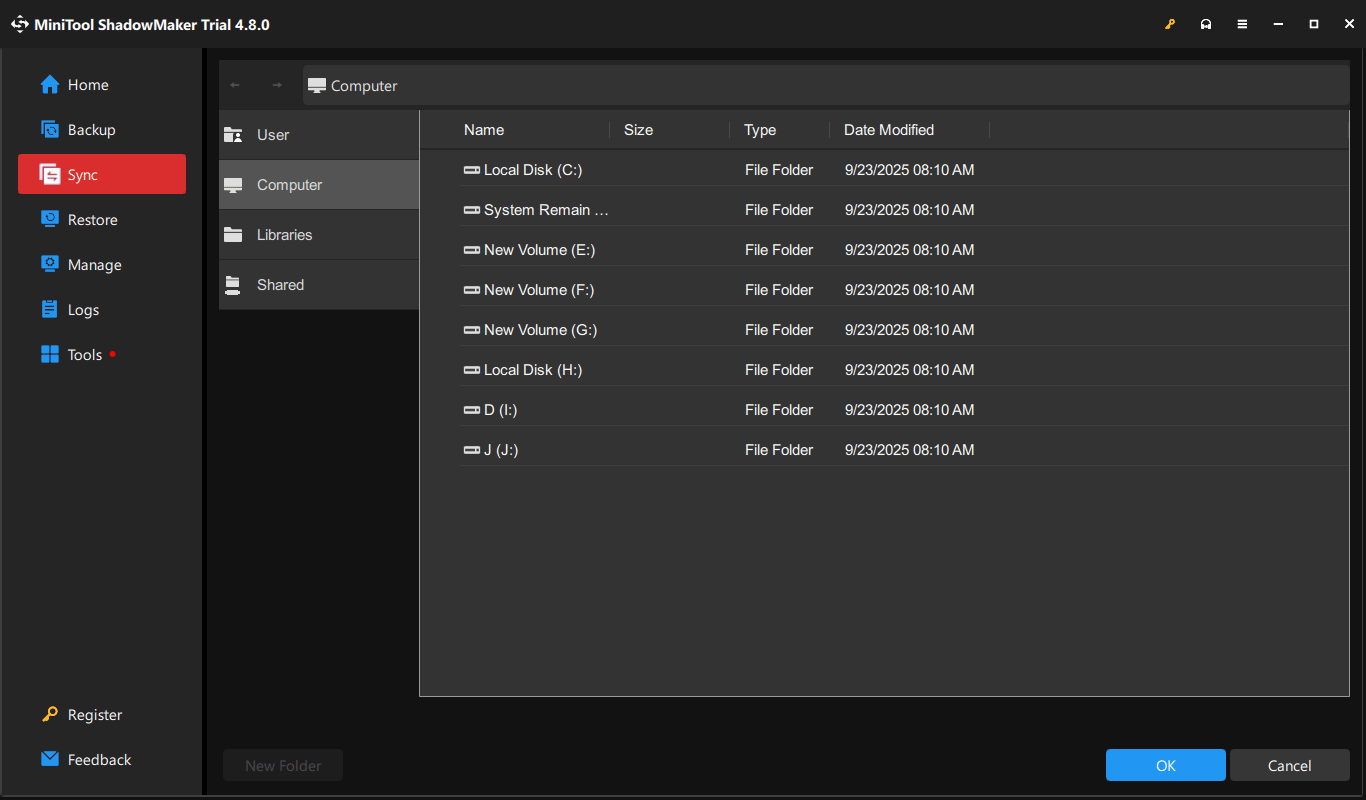
Step 3. Edit the Task Name
In the top left corner of the Sync page, you can modify the task name to make it easier to identify.
Step 4. Perform the Task
After checking all the details, you can click on Sync Now to start the process at once or delay the task by selecting Sync Later.
# Create an Automatic Sync Task with MiniTool ShadowMaker
Unlike OneDrive, MiniTool ShadowMaker supports creating a scheduled sync or backup task. Follow these instructions to create an automatic sync task with it:
Step 1. Go back to the Sync page and hit Options in the lower right corner.
Step 2. Toggle on Schedule Settings manually.
Step 3. Pick a specific time point of a day(s), week, or month, and then hit OK to save the changes.

Once a sync schedule is created, your tasks will be scheduled to run automatically at the time point that you set.
# OneDrive vs MiniTool ShadowMaker
What are the differences between OneDrive and MiniTool ShadowMaker? Now, please take a look at the table below, which compares the 2 products from several aspects.
| OneDrive | MiniTool ShadowMaker | |
| Supported OS | WindowsmacOSAndroidiOS | Windows 11/10/8.1/8/7Windows Server 2022/2019/2016/2012/2012 R2/2008/2008 R2 |
| Sync source | documents, photos, and other files | folder & files |
| Sync destination | cloud | local |
| Types of Sync | two-way sync | one-way sync |
| Automatic Sync | unsupported | supported |
| Internet connection | requires | not requires |
| Cost | 5GB of free storage | 30-day free trial |
Conclusion
Can you turn off or remove OneDrive from your computer? How to disable OneDrive? What will happen if OneDrive is disabled? Is there any alternative available for syncing files? By now, you must be aware of all the answers to them.
This guide introduces its alternative – MiniTool ShadowMaker – for you. It simplifies Windows PC backup and sync.
Do you encounter any problems while using MiniTool ShadowMaker? Welcome to share them with us via [email protected]. We will try our best to help you out!
How to Disable OneDrive FAQ
However, if a large number of files are synced simultaneously, it may temporarily occupy network bandwidth and disk space, causing lag. You can pause the task in OneDrive to alleviate this issue.
Step 2. Choose the files or folders that you want to remove from OneDrive.
Step 3. Drag and drop them into the folder on your PC.
Step 4. Go to the OneDrive website > find Recycle bin > select the items you removed before.
Step 5. Click on the Delete option on the top.
After reinstalling and logging in, you can reconfigure the synchronization folders. The files that were previously stored in the cloud can be downloaded again to your local device.
OneDrive: Developed by Microsoft, it is tightly integrated with Windows and Office.
Google Drive: It was developed by Google and seamlessly collaborates with Google services such as Gmail and Google Docs.
OneDrive and Google Drive differ in terms of free storage space, paid prices, and featured functions.
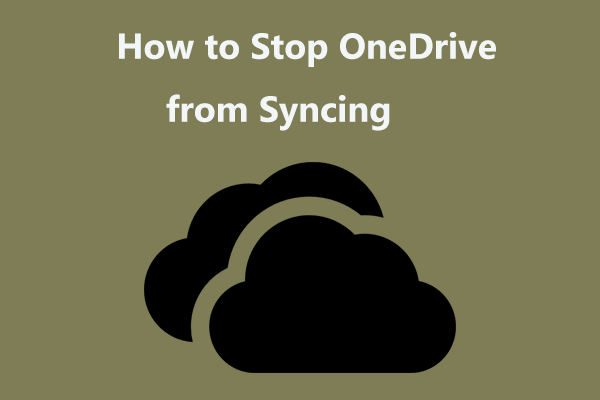
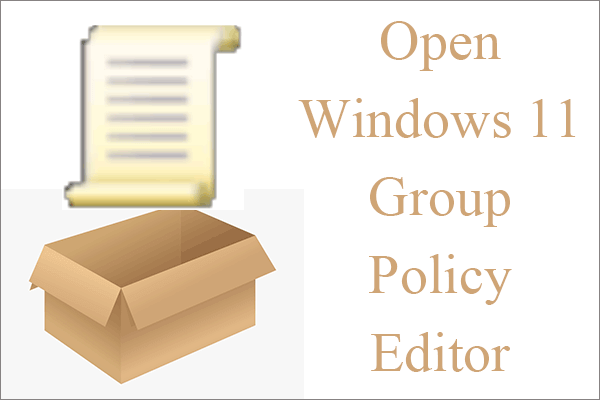

User Comments :